
Coats of arms of the Soviet Republics
Encyclopedia
The coats of arms
of the constituent republics
of the Union of Soviet Socialist Republics all featured predominantly the hammer and sickle
and the red star
that symbolised communism
, as well as a rising sun
(although in the case of the Latvian SSR
, since the Baltic Sea
is west of Latvia
, it could be interpreted as a setting sun), surrounded by a wreath
of wheat
(except the Karelo-Finnish SSR
with a wreath of rye
). The USSR State motto
, Workers of the world, unite!
, in both the republic's language and Russian
was also placed on each one of them. In addition to those repetitive motifs, coats of arms of many Soviet republics included also features that were characteristic of their local landscapes, economies or cultures.
The table below presents final versions of the renderings of the Soviet republics' coats of arms prior to the dissolution of the USSR
in 1991, as well as the arms of two republics that ceased to exist before that time. For comparison, national arms of present day successor states of the Soviet republics are also shown. As can be seen, most Asian post-Soviet republics use arms based on or reminiscent of the Soviet-era emblems. Most European republics, on the other hand, reverted to their traditional pre-Soviet arms. Belarus
used the traditional Pahonia
as its coat of arms from 1991 to 1995 when it was replaced by a new emblem closely resembling the Soviet-era design. Additionally, the secessionist Pridnestrovian Moldavian Republic (Transnistria), internationally recognised as part of Moldova
, uses an emblem based on the coat of arms of the Moldavian SSR
(see Coat of arms of Transnistria
).
Coat of arms
A coat of arms is a unique heraldic design on a shield or escutcheon or on a surcoat or tabard used to cover and protect armour and to identify the wearer. Thus the term is often stated as "coat-armour", because it was anciently displayed on the front of a coat of cloth...
of the constituent republics
Republics of the Soviet Union
The Republics of the Soviet Union or the Union Republics of the Soviet Union were ethnically-based administrative units that were subordinated directly to the Government of the Soviet Union...
of the Union of Soviet Socialist Republics all featured predominantly the hammer and sickle
Hammer and sickle
The hammer and sickle is a part of communist symbolism and its usage indicates an association with Communism, a Communist party, or a Communist state. It features a hammer and a sickle overlapping each other. The two tools are symbols of the industrial proletariat and the peasantry; placing them...
and the red star
Red star
A red star, five-pointed and filled, is an important ideological and religious symbol which has been used for various purposes, such as: state emblems, flags, monuments, ornaments, and logos.- Symbol of communism :...
that symbolised communism
Communism
Communism is a social, political and economic ideology that aims at the establishment of a classless, moneyless, revolutionary and stateless socialist society structured upon common ownership of the means of production...
, as well as a rising sun
Rising Sun
Rising Sun may refer to sunrise. It may also refer to:-Music:*"Rising Sun" , a song written by Fats Domino* Rising Sun , 2005* Rising Sun , 2010* Rising Sun , 1986...
(although in the case of the Latvian SSR
Latvian SSR
The Latvian Soviet Socialist Republic , also known as the Latvian SSR for short, was one of the republics that made up the Soviet Union. Established on 21 July 1940 as a puppet state during World War II in the territory of the previously independent Republic of Latvia after it had been occupied by...
, since the Baltic Sea
Baltic Sea
The Baltic Sea is a brackish mediterranean sea located in Northern Europe, from 53°N to 66°N latitude and from 20°E to 26°E longitude. It is bounded by the Scandinavian Peninsula, the mainland of Europe, and the Danish islands. It drains into the Kattegat by way of the Øresund, the Great Belt and...
is west of Latvia
Latvia
Latvia , officially the Republic of Latvia , is a country in the Baltic region of Northern Europe. It is bordered to the north by Estonia , to the south by Lithuania , to the east by the Russian Federation , to the southeast by Belarus and shares maritime borders to the west with Sweden...
, it could be interpreted as a setting sun), surrounded by a wreath
Wreath
A wreath is an assortment of flowers, leaves, fruits, twigs and/or various materials that is constructed to resemble a ring. They are used typically as Christmas decorations to symbolize the coming of Christ, also known as the Advent season in Christianity. They are also used as festive headdresses...
of wheat
Wheat
Wheat is a cereal grain, originally from the Levant region of the Near East, but now cultivated worldwide. In 2007 world production of wheat was 607 million tons, making it the third most-produced cereal after maize and rice...
(except the Karelo-Finnish SSR
Karelo-Finnish SSR
The Karelo-Finnish Soviet Socialist Republic was a short-lived republic that was a part of the former Soviet Union. The republic existed from 1940 until it was merged back into the Russian SFSR in 1956 ....
with a wreath of rye
Rye
Rye is a grass grown extensively as a grain and as a forage crop. It is a member of the wheat tribe and is closely related to barley and wheat. Rye grain is used for flour, rye bread, rye beer, some whiskeys, some vodkas, and animal fodder...
). The USSR State motto
USSR State motto
The Soviet Union state motto is a quotation from Karl Marx's and Friedrich Engels' Communist Manifesto, meaning Workers of the world, unite!....
, Workers of the world, unite!
Workers of the world, unite!
The political slogan Workers of the world, unite! is one of the most famous rallying cries of communism, found in The Communist Manifesto , by Karl Marx and Friedrich Engels...
, in both the republic's language and Russian
Russian language
Russian is a Slavic language used primarily in Russia, Belarus, Uzbekistan, Kazakhstan, Tajikistan and Kyrgyzstan. It is an unofficial but widely spoken language in Ukraine, Moldova, Latvia, Turkmenistan and Estonia and, to a lesser extent, the other countries that were once constituent republics...
was also placed on each one of them. In addition to those repetitive motifs, coats of arms of many Soviet republics included also features that were characteristic of their local landscapes, economies or cultures.
The table below presents final versions of the renderings of the Soviet republics' coats of arms prior to the dissolution of the USSR
Soviet Union
The Soviet Union , officially the Union of Soviet Socialist Republics , was a constitutionally socialist state that existed in Eurasia between 1922 and 1991....
in 1991, as well as the arms of two republics that ceased to exist before that time. For comparison, national arms of present day successor states of the Soviet republics are also shown. As can be seen, most Asian post-Soviet republics use arms based on or reminiscent of the Soviet-era emblems. Most European republics, on the other hand, reverted to their traditional pre-Soviet arms. Belarus
Belarus
Belarus , officially the Republic of Belarus, is a landlocked country in Eastern Europe, bordered clockwise by Russia to the northeast, Ukraine to the south, Poland to the west, and Lithuania and Latvia to the northwest. Its capital is Minsk; other major cities include Brest, Grodno , Gomel ,...
used the traditional Pahonia
Pahonia
The Pahonia , transliteration: Pahonya, , Lithuanian: Vytis, Pagaunė, is a historical symbol of Grand Duchy of Lithuania, of which the eastern part later became known as Belarus...
as its coat of arms from 1991 to 1995 when it was replaced by a new emblem closely resembling the Soviet-era design. Additionally, the secessionist Pridnestrovian Moldavian Republic (Transnistria), internationally recognised as part of Moldova
Moldova
Moldova , officially the Republic of Moldova is a landlocked state in Eastern Europe, located between Romania to the West and Ukraine to the North, East and South. It declared itself an independent state with the same boundaries as the preceding Moldavian Soviet Socialist Republic in 1991, as part...
, uses an emblem based on the coat of arms of the Moldavian SSR
Coat of arms of the Moldavian SSR
The coat of arms of the Moldavian Soviet Socialist Republic was adopted on February 10, 1941 by the government of the Moldavian Soviet Socialist Republic. The coat of arms is based on the coat of arms of the Soviet Union. It shows symbols of agriculture, an outer rim featuring wheat, corn, grapes...
(see Coat of arms of Transnistria
Coat of arms of Transnistria
The national emblem of Transnistria is a remodeled version of the former Moldavian Soviet Socialist Republic emblem, that was substituted by the internationally-recognized Moldovan government after the dissolution of the Soviet Union in 1991. The only major change made in the Transnistrian device...
).
| Republic | Emblem | Main article | Republic-specific features | Present-day national coat of arms |
|
|---|---|---|---|---|---|
| Armenian SSR Armenian SSR The Armenian Soviet Socialist Republic The Armenian Soviet Socialist Republic The Armenian Soviet Socialist Republic The Armenian Soviet Socialist Republic The Armenian Soviet Socialist Republic The Armenian Soviet Socialist Republic The Armenian Soviet Socialist Republic The Armenian Soviet... |
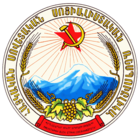 |
Coat of arms of the Armenian SSR Coat of arms of the Armenian SSR The coat of arms of the Armenian SSR was devised from an initial prototype sketch by Martiros Saryan, a famous Armenian painter and was adopted in 1937 by the government of the Armenian SSR.... |
Plants | wheat, grape Grape A grape is a non-climacteric fruit, specifically a berry, that grows on the perennial and deciduous woody vines of the genus Vitis. Grapes can be eaten raw or they can be used for making jam, juice, jelly, vinegar, wine, grape seed extracts, raisins, molasses and grape seed oil. Grapes are also... s |
 Coat of arms of Armenia Coat of arms of Armenia The national coat of arms of Armenia consists of an eagle and a lion supporting a shield. The coat of arms combines new and old symbols... |
| Landscapes, geographic features |
Mount Ararat Mount Ararat Mount Ararat is a snow-capped, dormant volcanic cone in Turkey. It has two peaks: Greater Ararat and Lesser Ararat .The Ararat massif is about in diameter... |
||||
| Industry | |||||
| Ornaments | |||||
| Azerbaijan SSR Azerbaijan SSR The Azerbaijan Soviet Socialist Republic , also known as the Azerbaijan SSR for short, was one of the republics that made up the former Soviet Union.... |
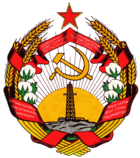 |
Coat of arms of the Azerbaijan SSR Coat of arms of the Azerbaijan SSR The national emblem of the Azerbaijan Soviet Socialist Republic was adopted in 1937 by the government of the Azerbaijan Soviet Socialist Republic. The device is based on the emblem of the Soviet Union.... |
Plants | wheat, cotton Cotton Cotton is a soft, fluffy staple fiber that grows in a boll, or protective capsule, around the seeds of cotton plants of the genus Gossypium. The fiber is almost pure cellulose. The botanical purpose of cotton fiber is to aid in seed dispersal.... |
 Coat of arms of Azerbaijan Coat of arms of Azerbaijan The state emblem of Azerbaijan mixes traditional and modern symbols. The focal point of the emblem is the fire symbol. This symbol comes from the fact that Azerbaijan has many everlasting fires which also gives the name "land of eternal fire".... |
| Landscapes, geographic features |
|||||
| Industry | oil Petroleum Petroleum or crude oil is a naturally occurring, flammable liquid consisting of a complex mixture of hydrocarbons of various molecular weights and other liquid organic compounds, that are found in geologic formations beneath the Earth's surface. Petroleum is recovered mostly through oil drilling... drilling rig Drilling rig A drilling rig is a machine which creates holes or shafts in the ground. Drilling rigs can be massive structures housing equipment used to drill water wells, oil wells, or natural gas extraction wells, or they can be small enough to be moved manually by one person... |
||||
| Ornaments | |||||
| Byelorussian SSR Byelorussian SSR The Byelorussian Soviet Socialist Republic was one of fifteen constituent republics of the Soviet Union. It was one of the four original founding members of the Soviet Union in 1922, together with the Ukrainian SSR, the Transcaucasian SFSR and the Russian Soviet Federative Socialist Republic... |
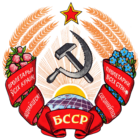 |
Coat of arms of the Byelorussian SSR Coat of arms of the Byelorussian SSR The Byelorussian SSR emblem was used as the coat of arms of the Soviet Socialist Republic until the fall of the Soviet Union. The coat of arms is based on the coat of arms of the Soviet Union.... |
Plants | wheat, clover Clover Clover , or trefoil, is a genus of about 300 species of plants in the leguminous pea family Fabaceae. The genus has a cosmopolitan distribution; the highest diversity is found in the temperate Northern Hemisphere, but many species also occur in South America and Africa, including at high altitudes... , flax Flax Flax is a member of the genus Linum in the family Linaceae. It is native to the region extending from the eastern Mediterranean to India and was probably first domesticated in the Fertile Crescent... |
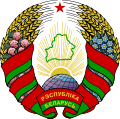 Coat of arms of Belarus |
| Landscapes, geographic features |
|||||
| Industry | |||||
| Ornaments | |||||
| Estonian SSR | Coat of arms of the Estonian SSR Coat of arms of the Estonian SSR The coat of arms of the Estonian SSR was adopted in 1940 by the government of the Estonian SSR. It features a sunrise accented by sunbeams, the hammer and sickle for the victory of communism and the "world-wide socialist community of states", and the red star to represent the affiliation to... |
Plants | wheat, pine Pine Pines are trees in the genus Pinus ,in the family Pinaceae. They make up the monotypic subfamily Pinoideae. There are about 115 species of pine, although different authorities accept between 105 and 125 species.-Etymology:... |
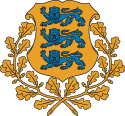 Coat of arms of Estonia Coat of arms of Estonia The coat of arms of Estonia is a golden shield which includes three slim blue passant gardant lions in the middle, with oak branches along the side of the shield. The three lions derive from the arms of Danish king Valdemar II who had conquered northern Estonia in 1219... |
|
| Landscapes, geographic features |
|||||
| Industry | |||||
| Ornaments | |||||
| Georgian SSR | 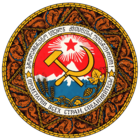 |
Coat of arms of the Georgian SSR | Plants | wheat, grapes |  Coat of arms of Georgia Coat of arms of Georgia (country) The coat of arms of the Republic of Georgia was adopted on 1 October 2004. It is partially based on the medieval arms of the Georgian royal house of Bagrationi.... |
| Landscapes, geographic features |
Caucasus Mountains Caucasus Mountains The Caucasus Mountains is a mountain system in Eurasia between the Black Sea and the Caspian Sea in the Caucasus region .The Caucasus Mountains includes:* the Greater Caucasus Mountain Range and* the Lesser Caucasus Mountains.... |
||||
| Industry | |||||
| Ornaments | Georgian ornament with a seven-pointed star from the pre-1921 Georgian coat of arms | ||||
| Kazakh SSR Kazakh SSR The Kazakh Soviet Socialist Republic , also known as the Kazakh SSR for short, was one of republics that made up the Soviet Union.At in area, it was the second largest constituent republic in the USSR, after the Russian SFSR. Its capital was Alma-Ata . Today it is the independent state of... |
 |
Coat of arms of the Kazakh SSR Coat of arms of the Kazakh SSR The coat of arms of the Kazakh Soviet Socialist Republic was adopted on March 26, 1937, by the government of the Kazakh Soviet Socialist Republic. The coat of arms is based on the coat of arms of the Soviet Union.... |
Plant | wheat | 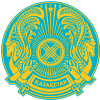 Coat of arms of Kazakhstan Coat of arms of Kazakhstan The emblem of Kazakhstan was adopted on June 4, 1992. The authors of the emblem are Jandarbek Melibekov and Shota Walikhanov. About 245 projects and 67 description designs of the future arms took part in the final competition.-Overview:... |
| Landscapes, geographic features |
|||||
| Industry | |||||
| Ornaments | |||||
| Kirghiz SSR Kirghiz Soviet Socialist Republic The Kirghiz Soviet Socialist Republic , also known as the Kirghiz SSR, the Kyrgyz SSR, or even Kirghizia, was one of republics that made up the Soviet Union... |
 |
Coat of arms of the Kirghiz SSR Coat of arms of the Kirghiz SSR The coat of arms of the Kirghiz Soviet Socialist Republic was adopted on March 23, 1937 by the government of the Kirghiz Soviet Socialist Republic. The coat of arms is based on the coat of arms of the Soviet Union. It shows symbols of agriculture on a backdrop of the Tian Shan mountains,... |
Plants | wheat, cotton Cotton Cotton is a soft, fluffy staple fiber that grows in a boll, or protective capsule, around the seeds of cotton plants of the genus Gossypium. The fiber is almost pure cellulose. The botanical purpose of cotton fiber is to aid in seed dispersal.... |
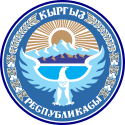 Coat of arms of Kyrgyzstan Coat of arms of Kyrgyzstan The emblem of Kyrgyzstan was adopted following the dissolution of the Soviet Union on 2 June 1992. The emblem has a circular form which mostly bears the color blue. Light blue is known as the Kyrgyz color of courage and generosity . To the left and right of the coat of arms, wheat and cotton are... |
| Landscapes, geographic features |
Tian Shan Tian Shan The Tian Shan , also spelled Tien Shan, is a large mountain system located in Central Asia. The highest peak in the Tian Shan is Victory Peak , .... Mountains |
||||
| Industry | |||||
| Ornaments | Kyrgyz embroidery Embroidery Embroidery is the art or handicraft of decorating fabric or other materials with needle and thread or yarn. Embroidery may also incorporate other materials such as metal strips, pearls, beads, quills, and sequins.... |
||||
| Latvian SSR Latvian SSR The Latvian Soviet Socialist Republic , also known as the Latvian SSR for short, was one of the republics that made up the Soviet Union. Established on 21 July 1940 as a puppet state during World War II in the territory of the previously independent Republic of Latvia after it had been occupied by... |
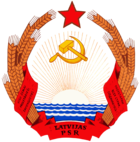 |
Coat of arms of the Latvian SSR Coat of arms of the Latvian SSR The coat of arms of the Latvian SSR was adopted on March 21, 1940, by the government of the Latvian SSR. The coat of arms is based on the coat of arms of the Soviet Union. It features symbols of agriculture and Latvia's maritime culture... |
Plants | wheat |  Coat of arms of Latvia Coat of arms of Latvia The Latvian national coat of arms was formed after the proclamation of an independent Republic of Latvia on November 18, 1918, and was officially adopted on June 16, 1921. It was especially created for its independent statehood... |
| Landscapes, geographic features |
Baltic Sea Baltic Sea The Baltic Sea is a brackish mediterranean sea located in Northern Europe, from 53°N to 66°N latitude and from 20°E to 26°E longitude. It is bounded by the Scandinavian Peninsula, the mainland of Europe, and the Danish islands. It drains into the Kattegat by way of the Øresund, the Great Belt and... |
||||
| Industry | |||||
| Ornaments | |||||
| Lithuanian SSR Lithuanian SSR The Lithuanian Soviet Socialist Republic , also known as the Lithuanian SSR, was one of the republics that made up the former Soviet Union... |
 |
Coat of arms of the Lithuanian SSR Coat of arms of the Lithuanian SSR The coat of arms of the Lithuanian Soviet Socialist Republic was adopted on 1940 by the government of the Lithuanian Soviet Socialist Republic. The coat of arms was designed by Vsevolodas Dobužinskis based on the coat of arms of the Soviet Union... |
Plants | wheat, oak Oak An oak is a tree or shrub in the genus Quercus , of which about 600 species exist. "Oak" may also appear in the names of species in related genera, notably Lithocarpus... |
 Coat of arms of Lithuania Coat of arms of Lithuania The coat of arms of Lithuania, consisting of an armor-clad knight on horseback holding an olden sword and shield, is also known as Vytis . The Lithuanian coat of arms is one of the oldest national coats of arms in Europe... |
| Landscapes, geographic features |
|||||
| Industry | |||||
| Ornaments | |||||
| Moldavian SSR Moldavian SSR The Moldavian Soviet Socialist Republic , commonly abbreviated to Moldavian SSR or MSSR, was one of the 15 republics of the Soviet Union... |
 |
Coat of arms of the Moldavian SSR Coat of arms of the Moldavian SSR The coat of arms of the Moldavian Soviet Socialist Republic was adopted on February 10, 1941 by the government of the Moldavian Soviet Socialist Republic. The coat of arms is based on the coat of arms of the Soviet Union. It shows symbols of agriculture, an outer rim featuring wheat, corn, grapes... |
Plants | wheat, maize Maize Maize known in many English-speaking countries as corn or mielie/mealie, is a grain domesticated by indigenous peoples in Mesoamerica in prehistoric times. The leafy stalk produces ears which contain seeds called kernels. Though technically a grain, maize kernels are used in cooking as a vegetable... , pear Pear The pear is any of several tree species of genus Pyrus and also the name of the pomaceous fruit of these trees. Several species of pear are valued by humans for their edible fruit, but the fruit of other species is small, hard, and astringent.... s, grapes |
 Coat of arms of Moldova Coat of arms of Moldova The coat of arms of Moldova consists of a stylized eagle holding a cross in its beak and a sceptre and an olive branch in its claws. According to the author of the coat of arms, the eagle symbolizes the Latin origin of the people.... |
| Landscapes, geographic features |
|||||
| Industry | |||||
| Ornaments | |||||
| Russian SFSR |  |
Coat of arms of the Russian SFSR | Plants | wheat |  Coat of arms of the Russian Federation |
| Landscapes, geographic features |
|||||
| Industry | |||||
| Ornaments | Baroque Baroque The Baroque is a period and the style that used exaggerated motion and clear, easily interpreted detail to produce drama, tension, exuberance, and grandeur in sculpture, painting, literature, dance, and music... cartouche Cartouche In Egyptian hieroglyphs, a cartouche is an ellipse with a horizontal line at one end, indicating that the text enclosed is a royal name, coming into use during the beginning of the Fourth Dynasty under Pharaoh Sneferu, replacing the earlier serekh... |
||||
| Tajik SSR Tajik SSR The Tajik Soviet Socialist Republic , also known as the Tajik SSR for short, was one of the 15 republics that made up the Soviet Union. Located in Central Asia, the Tajik SSR was created on 5 December 1929 as a national entity for the Tajik people within the Soviet Union... |
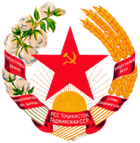 |
Coat of arms of the Tajik SSR Coat of arms of the Tajik SSR The coat of arms of the Tajik Soviet Socialist Republic was adopted on March 1, 1937 by the government of the Tajik Soviet Socialist Republic. The coat of arms is based on the coat of arms of the Soviet Union. It shows symbols of agriculture . The red star is prominently featured with a small... |
Plants | wheat, cotton Cotton Cotton is a soft, fluffy staple fiber that grows in a boll, or protective capsule, around the seeds of cotton plants of the genus Gossypium. The fiber is almost pure cellulose. The botanical purpose of cotton fiber is to aid in seed dispersal.... |
 Coat of arms of Tajikistan Coat of arms of Tajikistan The State Emblem of Tajikistan is a modified version of the original coat of arms of the Tajik SSR that was in use until the dissolution of the Soviet Union in 1991... |
| Landscapes, geographic features |
|||||
| Industry | |||||
| Ornaments | |||||
| Turkmen SSR Turkmen SSR The Turkmen Soviet Socialist Republic , also known as the Turkmen SSR for short, was one of republics of the Soviet Union in Central Asia. It was initially established on 7 August 1921 as the Turkmen Oblast of the Turkestan ASSR. On 13 May 1925 it was transformed into Turkmen SSR and became a... |
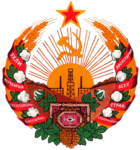 |
Coat of arms of the Turkmen SSR Coat of arms of the Turkmen SSR The coat of arms of the Turkmen Soviet Socialist Republic was adopted on March 2, 1937 by the government of the Turkmen Soviet Socialist Republic. The coat of arms is based on the coat of arms of the Soviet Union. It shows symbols of agriculture and heavy industry , as well as a symbol of the... |
Plants | wheat, cotton Cotton Cotton is a soft, fluffy staple fiber that grows in a boll, or protective capsule, around the seeds of cotton plants of the genus Gossypium. The fiber is almost pure cellulose. The botanical purpose of cotton fiber is to aid in seed dispersal.... , grapes |
 Coat of arms of Turkmenistan Coat of arms of Turkmenistan The State Emblem of Turkmenistan was created after Turkmenistan gained independence from the Soviet Union in 1991. The eight-point green starburst with golden edges features in its center a red circular disc which carries sheaves of wheat, five carpet guls, and centered upon that a smaller blue... |
| Landscapes, geographic features |
|||||
| Industry | oil Petroleum Petroleum or crude oil is a naturally occurring, flammable liquid consisting of a complex mixture of hydrocarbons of various molecular weights and other liquid organic compounds, that are found in geologic formations beneath the Earth's surface. Petroleum is recovered mostly through oil drilling... drilling rig Drilling rig A drilling rig is a machine which creates holes or shafts in the ground. Drilling rigs can be massive structures housing equipment used to drill water wells, oil wells, or natural gas extraction wells, or they can be small enough to be moved manually by one person... |
||||
| Ornaments | gillam detail from a Turkmen rug Yomut carpet The Yomut carpet is a type of Turkmen rug traditionally handwoven by the Yomut or Yomud, one of the major tribes of Turkmenistan. A Yomut design, along with designs of the four other major tribes, such as Ersari and Tekke, is featured on the coat of arms and the flag of Turkmenistan.-See... |
||||
| Ukrainian SSR Ukrainian SSR The Ukrainian Soviet Socialist Republic or in short, the Ukrainian SSR was a sovereign Soviet Socialist state and one of the fifteen constituent republics of the Soviet Union lasting from its inception in 1922 to the breakup in 1991... |
Coat of arms of the Ukrainian SSR Coat of arms of the Ukrainian SSR The coat of arms of the Ukrainian Soviet Socialist Republic was adopted on March 14, 1919 by the government of the Ukrainian Soviet Socialist Republic and subsequently modified on November 7, 1928, January 30, 1937 and November 21, 1949... |
Plants | wheat |  Coat of arms of Ukraine Coat of arms of Ukraine The state coat of arms of Ukraine or commonly the Tryzub is the national coat of arms of Ukraine, featuring the same colors found on the Ukrainian flag; a blue shield with yellow trident, called the tryzub... |
|
| Landscapes, geographic features |
|||||
| Industry | |||||
| Ornaments | Baroque Baroque The Baroque is a period and the style that used exaggerated motion and clear, easily interpreted detail to produce drama, tension, exuberance, and grandeur in sculpture, painting, literature, dance, and music... cartouche Cartouche In Egyptian hieroglyphs, a cartouche is an ellipse with a horizontal line at one end, indicating that the text enclosed is a royal name, coming into use during the beginning of the Fourth Dynasty under Pharaoh Sneferu, replacing the earlier serekh... |
||||
| Uzbek SSR Uzbek SSR The Uzbek Soviet Socialist Republic , also known as the Uzbek SSR for short, was one of the republics of the Soviet Union since its creation in 1924... |
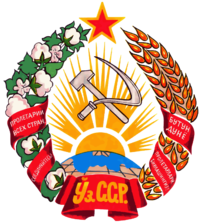 |
Coat of arms of the Uzbek SSR Coat of arms of the Uzbek SSR The coat of arms of the Uzbek Soviet Socialist Republic was adopted on February 14, 1937 by the government of the Uzbek Soviet Socialist Republic. The coat of arms is based on the coat of arms of the Soviet Union. It shows symbols of agriculture and heavy industry... |
Plants | wheat, cotton Cotton Cotton is a soft, fluffy staple fiber that grows in a boll, or protective capsule, around the seeds of cotton plants of the genus Gossypium. The fiber is almost pure cellulose. The botanical purpose of cotton fiber is to aid in seed dispersal.... |
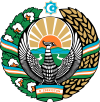 Coat of arms of Uzbekistan Coat of arms of Uzbekistan The state emblem of Uzbekistan was adopted on July 2, 1992. It is similar to the emblem of the previous Uzbek SSR. Like other post-Soviet republics whose symbols do not predate the October Revolution, the current emblem retains some components of the Soviet one.The emblem is in the form of a circle... |
| Landscapes, geographic features |
|||||
| Industry | |||||
| Ornaments | |||||
| Republics that dissolved before 1991 | |||||
| Karelo-Finnish SSR Karelo-Finnish SSR The Karelo-Finnish Soviet Socialist Republic was a short-lived republic that was a part of the former Soviet Union. The republic existed from 1940 until it was merged back into the Russian SFSR in 1956 .... (1940-1956) |
.png) |
Coat of arms of the Karelo-Finnish SSR Coat of arms of the Karelo-Finnish SSR The coat of arms of the Karelo-Finnish Soviet Socialist Republic was adopted on February 10, 1941 by the government of the Karelo-Finnish Soviet Socialist Republic and used until it was absorbed into the Russian Soviet Federative Socialist Republic in 1956.... |
Plants | rye Rye Rye is a grass grown extensively as a grain and as a forage crop. It is a member of the wheat tribe and is closely related to barley and wheat. Rye grain is used for flour, rye bread, rye beer, some whiskeys, some vodkas, and animal fodder... , pine Pine Pines are trees in the genus Pinus ,in the family Pinaceae. They make up the monotypic subfamily Pinoideae. There are about 115 species of pine, although different authorities accept between 105 and 125 species.-Etymology:... |
 Coat of arms of Karelia Coat of arms of the Republic of Karelia The coat of arms of the Russian Republic of Karelia is a rectangle on top of a semicircular bottom. It is thrice crossed in equal parts with the colors of the flag of Karelia shield with a profile of a rampant black bear. The golden frame of the shield comes into stylized image of a fir tree on the... (autonomous part of Russia Russia Russia or , officially known as both Russia and the Russian Federation , is a country in northern Eurasia. It is a federal semi-presidential republic, comprising 83 federal subjects... ) |
| Landscapes, geographic features |
Karelia Karelia Karelia , the land of the Karelian peoples, is an area in Northern Europe of historical significance for Finland, Russia, and Sweden... n landscape |
||||
| Industry | |||||
| Ornaments | Karelian embroidery Embroidery Embroidery is the art or handicraft of decorating fabric or other materials with needle and thread or yarn. Embroidery may also incorporate other materials such as metal strips, pearls, beads, quills, and sequins.... |
||||
| Transcaucasian SFSR Transcaucasian SFSR The Transcaucasian Socialist Federative Soviet Republic , also known as the Transcaucasian Soviet Federative Socialist Republic, the Transcaucasian SFSR and the TSFSR for short, was a short-lived republic of the Soviet Union, lasting from 1922 to 1936... (1922-1936) |
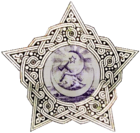 |
Coat of arms of the Transcaucasian SFSR Coat of arms of the Transcaucasian SFSR The coat of arms of the Transcaucasian SFSR was adopted by the government of the Transcaucasian SFSR. It is uncertain when exactly it was adopted.The coat of arms is based loosely on the coat of arms of the Soviet Union... |
Plant | ||
| Landscapes, geographic features |
Mount Ararat (symbolising Armenia Armenia Armenia , officially the Republic of Armenia , is a landlocked mountainous country in the Caucasus region of Eurasia... ) |
||||
| Industry | |||||
| Ornaments | Crescent Crescent In art and symbolism, a crescent is generally the shape produced when a circular disk has a segment of another circle removed from its edge, so that what remains is a shape enclosed by two circular arcs of different diameters which intersect at two points .In astronomy, a crescent... (symbolising Azerbaijan Azerbaijan Azerbaijan , officially the Republic of Azerbaijan is the largest country in the Caucasus region of Eurasia. Located at the crossroads of Western Asia and Eastern Europe, it is bounded by the Caspian Sea to the east, Russia to the north, Georgia to the northwest, Armenia to the west, and Iran to... ), Georgian ornament (symbolising Georgia Georgia (country) Georgia is a sovereign state in the Caucasus region of Eurasia. Located at the crossroads of Western Asia and Eastern Europe, it is bounded to the west by the Black Sea, to the north by Russia, to the southwest by Turkey, to the south by Armenia, and to the southeast by Azerbaijan. The capital of... ) |
||||
See also
- Flags of the Soviet RepublicsFlags of the Soviet RepublicsThe Flags of the Soviet Socialist Republics were all defaced versions of the flag of the Soviet Union, which featured a golden hammer and sickle, , and a gold-bordered red star on a red field...
- Coats of arms of the Yugoslav Socialist Republics

